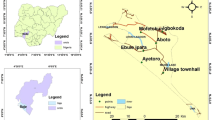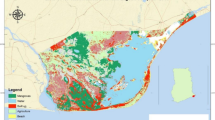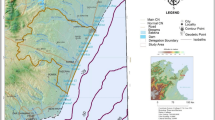Abstract
The research summarized here determines historical shoreline changes along Lake Sapanca by using Remote Sensing (RS) and Geographical Information Systems (GIS). Six multi-temporal satellite images of Landsat Multispectral Scanner (L1-5 MMS), Enhanced Thematic Mapper Plus (L7 ETM+), and Operational Land Imager Sensors (L8 OLI), covering the period between 17 June 1975 and 15 July 2016, were used to monitor shoreline positions and estimate change rates along the coastal zone. After pre-possessing routines, the Normalized Difference Water Index (NDWI), Modified Normalized Difference Water Index (MNDWI), and supervised classification techniques were utilized to extract six different shorelines. Digital Shoreline Analysis System (DSAS), a toolbox that enables transect-based computations of shoreline displacement, was used to compute historical shoreline change rates. The average rate of shoreline change for the entire cost was 2.7 m/year of progradation with an uncertainty of 0.2 m/year. While the great part of the lake shoreline remained stable, the study concluded that the easterly and westerly coasts and deltaic coasts are more vulnerable to shoreline displacements over the last four decades. The study also reveals that anthropogenic activities, more specifically over extraction of freshwater from the lake, cyclic variation in rainfall, and deposition of sediment transported by the surrounding creeks dominantly control spatiotemporal shoreline changes in the region. Monitoring shoreline changes using multi-temporal satellite images is a significant component for the coastal decision-making and management.









Similar content being viewed by others
References
Al Fugura, A., Billa, L., & Pradhan, B. (2011). Semi-automated procedures for shoreline extraction using single RADARSAT-1 SAR image. Estuarine, Coastal and Shelf Science, 95(4), 395–400.
Alesheikh, A. A., Ghorbanali, A., & Nouri, N. (2007). Coastline change detection using remote sensing. International journal of Environmental Science and Technology, 4(1), 61–66.
Al-Hatrushi, S. M. (2013). Monitoring of the shoreline change using remote sensing and GIS: a case study of Al Hawasnah tidal inlet, Al Batinah coast, Sultanate of Oman. Arabian Journal of Geosciences. doi:10.1007/s12517-011-0424-2.
Bachofer, F., Queneherve, G., & Marker, M. (2014). The delineation of paleo-shorelines in the Lake Manyara Basin using TerraSAR-X data. Remote Sensing. doi:10.3390/rs6032195.
Bayram, B., Seker, D. Z., Acar, U., Yuksel, Y., Anil, H., Ari, G., & Cetin, I. (2013). An integrated approach to temporal monitoring of the shoreline and basin of Terkos Lake. Journal of Coastal Research, 29(6), 1427–1435.
Bin, O., Kruse, J. B., & Landry, C. E. (2008). Flood hazards, insurance rates, and amenities: evidence from the coastal housing market. Journal of Risk and Insurance, 75(1), 63–82.
Boahen, K. A., Emmanuel, A. M., Kwaku, K. K., & Osman, A. (2014). Socio-economic impact of Lake Bosomtwe shoreline changes on catchment residents in Ghana. International Journal of Scientific and Research Publications, 4(2), 1–7.
Bumshick, S., & Kyuhan, K. (2015). Estimation of shoreline change using high resolution images. Procedia Engineering, 116, 994–1001.
Ceribasi, G., & Dogan, E. (2016). Trend analysis of average annual for Black Sea and Sakarya Basins. SDU International Journal of Technological Science, 7(1), 1–7.
Coops, H., Beklioglu, M., & Crisman, T. L. (2003). The role of water-level fluctuations in shallow lake ecosystems—workshop conclusions. Hydrobiologia, 23(27), 506–509.
Cui, B. L., & Li, X. Y. (2011). Coastline change of the Yellow River estuary and its response to the sediment and runoff (1976–2005). Geomorphology, 127, 32–40.
Dellepiane, S., DeLaurentiis, R., & Giordano, F. (2004). Coastline extraction from SAR images and a method for the evaluation of the coastline precision. Pattern Recognition Letters, 25, 1461–1470.
Doğa Society. (2006). Important nature fields of Turkey. Turkey: Ankara.
Durduran, S. S. (2010). Coastline change assessment on water reservoirs located in the Konya Basin Area, Turkey, using multitemporal Landsat imagery. Environmental Monitoring & Assessment, 164, 453–461.
Ekercin, S. (2007). Coastline change assessment at the Aegean Sea coasts in Turkey using multitemporal Landsat Imagery. Journal of Coastal Research, 23(3), 691–698.
El-Asmar, H. M., & Hereher, M. (2011). Change detection of the coastal zone east of the Nile Delta using remote sensing. Environmental Earth Sciences, 62(4), 769–777.
Ford, M. (2013). Shoreline changes interpreted from multi-temporal aerial photographs and high resolution satellite images: Wotje Atoll Marshall Islands. Remote Sensing of Environment, 135, 130–140.
Gurbuz, A., & Gurer, O. F. (2008). Anthropogenic affects on lake sedimentation process: a case study from Lake Sapanca, NW Turkey. Environmental Geology. doi:10.1007/s00254-007-1165-0.
Hereher, M. (2011). Mapping coastal erosion at the Nile Delta western promontory using Landsat imagery. Environmental Earth Sciences, 64(4), 1117–1125.
Jangir, B., Satyanarayana, A. N. V., Swati, S., Jayaram, C., Chowdary, V. M., & Dadhwal, V. K. (2016). Delineation of spatio-temporal changes of shoreline and geomorphological features of Odisha coast of India using remote sensing and GIS techniques. Natural Hazards. doi:10.1007/s11069-016-2252-x.
Kalkan, K., Bayram, B., Maktav, D., & Sunar, F. (2013). Comparison of support vector machine and object based classification methods for coastline detection. International Archives of the Photogrammetry, Remote Sensing and Spatial Information Sciences, Volume XL-7/W2, ISPRS2013-SSG, Antalya, Turkey.
Karimi, N., & Mobasheri, M.R. (2011). Shoreline change analysis of Urmia Lake using multi-temporal satellite images. Eighteenth National Conference on Geomatics, Iran, Tehran. 88–96 p.
Kuleli, T. (2010). Quantitative analysis of shoreline Changes at the Mediterranean Coast in Turkey. Environmental Monitoring & Assessment, 167(4), 387–397.
Kumari, P., Jnaneswari, K., Rao, D., & Sridhar, D. (2012). Application of remote sensing and geographical information system techniques on geomorphological mapping of coastal part of East Godavari district. Andhra Pradesh, India. International Journal of Engineering Science Technology, 4, 4296–4300.
Lewin, W. C., Mehner, T., Ritterbusch, D., & Bramick, U. (2014). The influence of anthropogenic shoreline changes on the littoral abundance of fish species in German lowland lakes varying in depth as determined by boosted regression trees. Hydrobiologia. doi:10.1007/s10750-013-1746-8.
Liu, H., Sherman, D., & Gu, S. (2007). Automated extraction of shorelines from airborne light detection and ranging data and accuracy assessment based on Monte Carlo simulation. Journal of Coastal Research, 23(6), 1359–1369.
Mann, T., Bayliss, T. S., & Westphal, H. (2016). A geomorphic interpretation of shoreline change rates on Reef Islands. Journal of Coastal Research, 32(3), 500–507.
Martin, P. H., LeBoeuf, E. J., Dobbins, J. P., Daniel, E. B., & Abkowitz, M. D. (2005). Interfacing GIS with water resource models: a state-of-the-art review. Journal of the American Water Resources Association (JAWRA). doi:10.1111/j.1752-1688.2005.tb03813.x.
McFeeters, S. K. (1996). The use of Normalized Difference Water Index (NDWI) in the delineation of open water features. International Journal of Remote Sensing, 17(7), 1425–1432.
Moussa, M., Baccar, L., & Ben Khemis, R. (2005). La lagune de Ghar El Melh: Diagnostic écologique et perspectives d'aménagement hydraulique. Revue des Sciences Del'Eau, 18, 13–26.
Mujabar, P. S., & Chandrasekar, N. (2013). Shoreline change analysis along the coast between Kanyakumari and Tuticorin of India using remote sensing and GIS. Arabian Journal of Geosciences, 6(3), 647–664.
Nandi, S., Ghosh, M., Kundu, A., Dipanwita, D., & Moumita, B. (2016). Shoreline shifting and its prediction using remote sensing and GIS techniques: a case study of Sagar Island, West Bengal (India). Journal of Coastal Conservation. doi:10.1007/s11852-015-0418-4.
Natesan, U., Thulasiraman, N., Deepthi, K., & Kathiravan, K. (2013). Shoreline change analysis of Vedaranyam coast, Tamil Nadu, India. Environmental Monitoring & Assessment, 185(6), 5099–5109.
Nsubuga, F. N., Botai, J. O., Olwoch, J. M., Dew Rautenbach, C. J., Kalumba, A. M., Tsela, P., et al. (2015). Detecting changes in surface water area of Lake Kyoga sub-basin using remotely sensed imagery in a changing climate. Theoretical and Applied Climatology. doi:10.1007/s00704-015-1637.
Ormeci, C., & Ekercin, S. (2007). An assessment of water reserve change in the Salt Lake, Turkey through multitemporal Landsat imagery and real-time ground surveys. Hydrological Processes. doi:10.1002/hyp.6355.
Paterson, S.K., O’Donnell, A., Loomis, D.K., & Hom, P. (2010). The social and economic effects of shoreline change: North Atlantic, South Atlantic, Gulf of Mexico, and Great Lakes regional overview. Final Report, Human Dimensions of Natural Resource Management Research Unit, Department of Natural Resources Conservation University of Massachusetts, Amherst, MA.
Ryu, J. H., Won, J. S., & Min, K. D. (2002). Waterline extraction from Landsat TM data in a tidal flat: a case study in Gosmo Bay, Korea. Remote Sensing of the Environment. doi:10.1016/S0034-4257(02)00059-7.
Sarp, G., & Ozcelik, M. (2016). Water body extraction and change detection using time series: a case study of Lake Burdur, Turkey. Journal of Taibah Univverity of Science. doi:10.1016/j.jtusci.2016.04.005.
Sarwar, M., & Woodroffe, C. D. (2013). Rates of shoreline change along the coast of Bangladesh. Journal of Coastal Conservation, 17(3), 515–526.
Schindler, D. E., & Scheuerell, M. D. (2002). Habitat coupling in lake ecosystems. Oikos, 97, 177–189.
Schmieder, K. (2004). European lake shores in danger—concepts for a sustainable development. Limnologica, 34, 3–14.
Sener, E., Davraz, A., & Sener, S. (2009). Investigation of Akşehir and Eber Lakes (SW Turkey) coastline change with multitemporal satellite images. Water Resource Management, 26(4), 727–745.
Smith, R.V., Belknap, D.F. & Kelley, J.T. (1987). The role of bluff erosion and sediment recycling in shaping Maine’s coastline. Geological Society of America Abstract with Programs, 19, 58 p.
Stockdon, H. F., Sallenger, A. H., List, J. H., & Holman, R. A. (2002). Estimation of shoreline position and change using airborne topographic LiDAR data. Journal of Coastal Research, 18(3), 502–513.
Sudha Rani, N. N. V., Satyanarayana, A. N. V., & Bhaskaran, P. K. (2015). Coastal vulnerability assessment studies over India: a review. Natural Hazards. doi:10.1007/s11069-015-1597-x.
Tagil, S. (2007). Quantifying the change detection of the Uluabat wetland, Turkey, by use of Landsat Images. Ekoloji, 16(64), 9–20.
Tao, S., Fang, J., Zhao, X., Zhao, S., Shen, H., Hu, H., & Turner, B. L. (2015). Rapid loss of lakes on the Mongolian Plateau. Proceedings of the National Academy of Sciences of the United States of America. doi:10.1073/pnas.1411748112.
Temiz, F., & Durduran, S. (2016). Monitoring coastline change using remote sensing and GIS technology: a case study of Acıgöl Lake, Turkey. IOP Conf. Series: Earth and Environmental Science. doi:10.1088/1755-1315/44/1/011001.
Thieler, E.R., Himmelstoss, E.A., Zichichi, J.L., & Ergul, A. (2009). Digital Shoreline Analysis System (DSAS) version 4.0—an ArcGIS extension for calculating shoreline change: U.S. Geological Survey Open-File Report 2008–1278.
Tonisso, H., Suursarr, U., & Kont, A. (2012). Maps, aerial photographs, orthophotos and GPS data as a source of information to determine shoreline changes, coastal geomorphic processes and their relation to hydrodynamic conditions on Osmussa island, The Baltic sea. IGRSS, 12, 987–1159.
Wallick, J. R., Lancaster, S. T., & Bolte, J. P. (2006). Determination of bank erodibility for natural and anthropogenic bank materials using a model of lateral migration and observed erosion along the Willamette River, Oregon, USA. River Research & Applications, 22, 631–649.
Wang, Y., & Allen, T. R. (2008). Estuarine shoreline change detection using Japanese ALOSPALSAR HH and JERS-1 L-HH SAR data in the Albemarle-Pamlico Sounds, North Carolina, USA. International Journal of Remote Sensing, 29, 4429–4442.
WWF. (2015). Water risk and economy in Lake Sapanca report. Istanbul: Gorsel Design and Offset Press.
Xu, H. (2006). Modification of normalized difference water index (NDWI) to enhance open water features in remotely sensed imagery. International Journal of Remote Sensing, 27(14), 3025–3033.
Yoon, J. H., Kang, S. J., & Oh, T. K. (2008). Roseovarius aestuarii sp. nov., isolated from a tidal flat of the Yellow Sea in Korea. International Journal of Systematic and Evolutionary Microbiology, 58, 1198–1202.
Zhang, A., Hu, S., Jin, X., & Sun, W. (2005). A method of merging aerial images and ground laser scans. In: Geoscience and remote sensing symposium. IGARSS '05, 222–225 p.
Author information
Authors and Affiliations
Corresponding author
Rights and permissions
About this article
Cite this article
Duru, U. Shoreline change assessment using multi-temporal satellite images: a case study of Lake Sapanca, NW Turkey. Environ Monit Assess 189, 385 (2017). https://doi.org/10.1007/s10661-017-6112-2
Received:
Accepted:
Published:
DOI: https://doi.org/10.1007/s10661-017-6112-2




